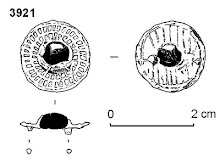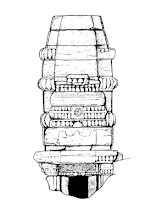We are waiting for the last of the team to arrive and are still
in the town of Surkhet, down at about 700m altitude in the middle of a
roughly circular valley surrounded by hills. The town has got increasingly busy over the 13
years since my last visit and has a large bustling bazaar and on a sunny day
like this is a great place to soak up the atmosphere of being back in Nepal.
This morning I went on a short sightseeing
trip to the remains of the Buddhist Kankrevihar temple which is about 15
minutes drive outside Surkhet on a wooded hill in the centre of the valley.
The temple had either collapsed or been destroyed at some
point in the past and the site was
first discovered by Nepali explorer and archaeologist Yogi
Naraharinath in the 1950s and was partially excavated in 2003 by the Nepali
Department of Archaeology. The decorative stonework has all been catalogued and
drawn, which when you see the amount of stone lying around the temple site is
certainly impressive. From the drawn records the original design of the temple
has been reconstructed on paper, and the temple base, foundation (or ‘socle’)
and the lowest course of the superstructure of the temple has been physically reconstructed
and gives an impression of the size and scale of the temple. There has been talk
of reconstructing the entire temple –reinforcing rods are visible in the corners
of the rebuilt superstructure, although that would clearly be a literally monumental
undertaking. As part of the Surkhet Valley Project Cambridge Archaeological
Unit staff carried out a further survey of the temple in 2010. |
| Intricately carved stone in floral motif, probably from the underside of the ceiling of the inner sanctum of the temple |
The date of the temple is currently unclear and it is hoped
that further work on the architectural styles will resolve whether it dates
from as early as the eleventh or twelfth centuries, or the thirteenth or
fourteenth century.
Surrounded by Sal trees decorated with prayer flags the
decorated stones are strewn around the temple base, some are moss covered, it
was a wonderfully tranquil spot today and you can walk around spotting
intricate carvings amongst the trees. The best of the carvings are housed in
two modern corrugated tin-roofed sheds with the best of the figurative
sculpture in the Surkhet Museum.
 |
| Decorative carvings stored on site |
Because the temple has collapsed you can see
the individual carvings right close up, and also see how the temple was
originally constructed with iron staples joining the blocks together. Similar
techniques are used on the far simpler and smaller temples and monuments we will be recording from
tomorrow.
 | |
| Stone block with slots for iron staples, and semi-circular indents which may be for helping position the blocks |
The temple complex may have been built during the rule of the Khasa Malla dynasty whose archaeology and architecture we will be recording on this visit. West Nepal, and the Malla kingdom in particular, were the cradle of Nepali culture and language before the centre of power moved to the Kathmandu Valley area in the post-medieval period. There are numerous temples, pillar stones, nauli (waterpoints or tanks) and other monuments scattered across West Nepal and we will be recording a sample of these within Dailekh district which contains the summer capital of the Malla kingdom at Dullu. The Malla monuments have a distinctive regional style which combines elements of Tibetan and Indian, Buddhist and Hindu architecture and we will be working towards recording and understanding the Malla school of architecture.
 | |
| Gateway to site with conjectured reconstruction of the temple |















No comments:
Post a Comment